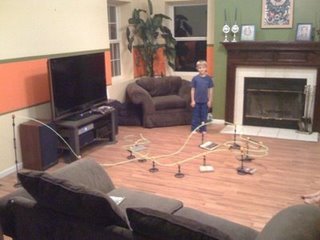If you’ve ever bought a marble run, rollercoaster or any other type of plastic track that requires hours of set up and falls to pieces at the wrong touch, then you’ll appreciate this idea.
Last week, my wife and kids set up a marble run in our living room. It took hours to set up because the tracks kept falling over. The bases were too light to hold up any track over a foot tall. Once they had all the bases secured down with heavy books they had to contend a new problem–the ball jumping the tracks on tight turns.

They got it working finally, but making any changes to it would have been frustrating so the result ended up to be pretty static and they took it down that night. I thought it seemed like a perfect solution for a console AR game.
The advantage of using a console (Wii, XBox, Playstation3, etc) is that the structure of AR family entertainment center is already in place. With a big screen TV, a wide open space, and camera, the living room could be converted into an exciting game center. In much the same way that the Wii revolutionized interaction with the console games with gesture based gaming, AR could up the ante by providing a visual context for the games.
Using the simple idea of the marble run, operators could place tracks in their living room using the controller. The program could snap them together creaing fantasical designs. If you wanted to learn more about physics, you could have a “realistic” version that shot the marble off if you made the tracks wrong.
Roller coaster design games like Roller Coaster Tycoon have been around for years on the PC, but using AR could reinvigorate them by making the game come to life in the living room. The use of AR should be brought to market in the same way as the Wii. They didn’t have better graphics, but instead showed how getting people physically involved with the games got people interested, even people that had never played games before.
